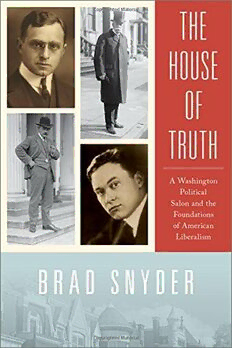
The House of Truth: a Washington political salon and the foundations of American liberalism PDF
Preview The House of Truth: a Washington political salon and the foundations of American liberalism
THE HOUSE OF TRUTH THE HOUSE OF TRUTH A Washington Political Salon and the Foundations of American Liberalism BRAD SNYDER 1 1 Oxford University Press is a department of the University of Oxford. It furthers the University’s objective of excellence in research, scholarship, and education by publishing worldwide. Oxford is a registered trade mark of Oxford University Press in the UK and certain other countries. Published in the United States of America by Oxford University Press 198 Madison Avenue, New York, NY 10016, United States of America. © Brad Snyder 2017 All rights reserved. No part of this publication may be reproduced, stored in a retrieval system, or transmitted, in any form or by any means, without the prior permission in writing of Oxford University Press, or as expressly permitted by law, by license, or under terms agreed with the appropriate reproduction rights organization. Inquiries concerning reproduction outside the scope of the above should be sent to the Rights Department, Oxford University Press, at the address above. You must not circulate this work in any other form and you must impose this same condition on any acquirer. Library of Congress Cataloging-i n- Publication Data Names: Snyder, Brad, author. Title: The House of Truth : a Washington political salon and the foundations of American liberalism / Brad Snyder. Description: New York, NY : Oxford University Press, [2017] | Includes bibliographical references and index. Identifiers: LCCN 2016014092 | ISBN 9780190261986 (alk. paper) Subjects: LCSH: Washington (D.C.)—Politics and government—20th century. | Washington (D.C.)—Intellectual life—20th century. | Washington (D.C.)—Social life and customs—20th century. | Salons—Washington (D.C.)—History— 20th century. | Political culture—Washington (D.C.)—History—20th century. | Politicians—United States—Biography. | Intellectuals—United States—Biography. | Liberalism—United States—History—20th century. | United States—Politics and government—1913-1921. | United States—Politics and government—1919–1933. Classification: LCC F199 .S67 2017 | DDC 975.3/04—dc23 LC record available at https://lccn.loc.gov/2016014092 1 3 5 7 9 8 6 4 2 Printed by Sheridan Books, Inc., United States of America To Shelby, Lily, and Max Contents Introduction 1 1. Expanding Horizons 6 2. 1727 Nineteenth Street 13 3. The Call of the Moose 38 4. The Center of the Universe 61 5. Buddha 84 6. The Soldier’s Faith 98 7. Temperamentally Unfit 122 8. Our Founder 147 9. Fighting Valentine’s Fight 158 10. The House at War 167 11. One- Man War 188 12. Uniting the Labor Army 209 13. The Inquiry 226 14. The Wonderful One 237 15. “The H/ T Cannot Be Re- constituted” 270 16. Harvard’s Dangerous Men 274 17. Touched with Fire 305 viii Contents 18. Protestant of Nordic Stock 322 19. We Live by Symbols 341 20. The 1924 Election and the Basic Issues of Liberalism 365 21. Eloquence May Set Fire to Reason 384 22. A Fly on an Elephant 396 23. No Ordinary Case 409 24. This World Cares More for Red Than for Black 442 25. A Damn Poor Psychologist 477 26. The Happy Warrior 488 27. Freedom for the Thought That We Hate 498 28. America’s Shrine for Political Democracy 508 29. The Best Men 516 30. A Very Great Beginning 541 31. The Hard Case Has Melted 556 Epilogue 565 Appendix 581 Notes 583 Selected Bibliography 741 Acknowledgments 773 Index 777 Introduction In 1918, a small group of friends gathered for dinner at a row house near Washington’s Dupont Circle: a young lawyer named Felix Frankfurter; a seventy- seven- year- old Supreme Court justice, Oliver Wendell Holmes Jr., and his wife, Fanny; and perhaps the most unlikely guest, the sculptor Gutzon Borglum. As they sat around the dining room table, Borglum de- scribed his latest idea for a sculpture. He wanted, he explained to the other guests, to carve monumentally large images of Confederate war heroes into the side of Stone Mountain, Georgia. Justice Holmes, a Union army vet- eran who had always admired his Confederate foes, expressed interest in Borglum’s idea. Yet he could not fully grasp the sculptor’s vision.1 Borglum, a Westerner whose cowboy hat, bushy mustache, and stocky frame reflected his frontier beginnings, pushed the plates to the center of the table and began drawing on the white tablecloth.2 He depicted three men in the foreground, all of them on horseback: Robert E. Lee on his legendary horse, Traveller; Stonewall Jackson, slightly in front of Lee; and Jefferson Davis closely behind them. There were clusters of cavalrymen in the background. The desired effect, Borglum explained, was to march the Confederate army across the 800-b y-1 ,500-f oot face of the mountain. Holmes was delighted and astonished. Frankfurter never forgot the encounter. As it turned out, Borglum never finished his Confederate memorial (mainly because of a dispute with the Ku Klux Klan, an organization he had embraced). Nonetheless, his first attempt at mountain carving led to what became the major work of his lifetime: memorializing four American presidents in the Black Hills of South Dakota at Mount Rushmore. By the time Frankfurter, Holmes, and Borglum dined there that night, they had eaten many meals together at this narrow, three-s tory, red- brick row house that its residents self-m ockingly but fondly referred to as the “House of Truth.” The name was inspired by debates between Holmes and its residents about the search for truth. During these discussions, Frankfurter
